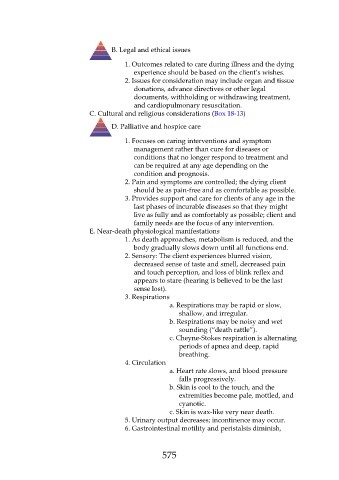Page 575 - Saunders Comprehensive Review For NCLEX-RN
P. 575
B. Legal and ethical issues
1. Outcomes related to care during illness and the dying
experience should be based on the client’s wishes.
2. Issues for consideration may include organ and tissue
donations, advance directives or other legal
documents, withholding or withdrawing treatment,
and cardiopulmonary resuscitation.
C. Cultural and religious considerations (Box 18-13)
D. Palliative and hospice care
1. Focuses on caring interventions and symptom
management rather than cure for diseases or
conditions that no longer respond to treatment and
can be required at any age depending on the
condition and prognosis.
2. Pain and symptoms are controlled; the dying client
should be as pain-free and as comfortable as possible.
3. Provides support and care for clients of any age in the
last phases of incurable diseases so that they might
live as fully and as comfortably as possible; client and
family needs are the focus of any intervention.
E. Near-death physiological manifestations
1. As death approaches, metabolism is reduced, and the
body gradually slows down until all functions end.
2. Sensory: The client experiences blurred vision,
decreased sense of taste and smell, decreased pain
and touch perception, and loss of blink reflex and
appears to stare (hearing is believed to be the last
sense lost).
3. Respirations
a. Respirations may be rapid or slow,
shallow, and irregular.
b. Respirations may be noisy and wet
sounding (“death rattle”).
c. Cheyne-Stokes respiration is alternating
periods of apnea and deep, rapid
breathing.
4. Circulation
a. Heart rate slows, and blood pressure
falls progressively.
b. Skin is cool to the touch, and the
extremities become pale, mottled, and
cyanotic.
c. Skin is wax-like very near death.
5. Urinary output decreases; incontinence may occur.
6. Gastrointestinal motility and peristalsis diminish,
575

